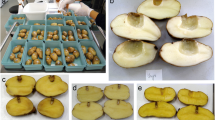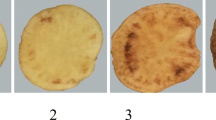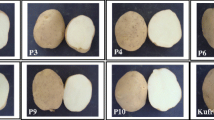Abstract
The aim of this work is the evaluation of tetraploid potato clones with germplasm fromS. chacoense andS. phureja for chipping and resistance to tuber soft rot (Erwinia carotovora subsp.carotovora). Tetraploid potato clones were obtained via 2n eggs through 2x–4x crosses. Cytological mechanisms were investigated in the diploid hybrid 2n-egg producer used as parent in the unilateral sexual polyploidization scheme; the omission of the second meiotic division and cytokinesis failure at the end of meiosis were identified with a genetic consequence equivalent to second division restitution (SDR). Tuber marketable yield, specific gravity and chip-processing ability evaluated at harvest and after cold storage with and without reconditioning were higher in some clones as compared to theS. tuberosum tetraploid parent. Tuber soft rot resistance, contributed byS. chacoense, was successfully transferred to the4x level. After inoculation withErwinia carotovora subsp.carotovora and estimation of the rotted area, one tetraploid clone proved to be resistant and three partially resistant. The genetic value of exotic germplasm and sexual polyploidization strategy are discussed in relation to potato improvement.
Resumen
El objetivo de este trabajo es la evaluatión de clones tetraploides de papa con germoplasma deS. chacoense yS. phureja para hojuelas y para resistencia a la pudrición blanda del tubérculo (Erwinia carotovora subsp.carotovora). Los clones tetraploides fueron obtenidos mediante cruces 2x–4x, utilizando gametos 2n. Los mecanismos citológicos fueron investigados en el productor diploide del híbrido del gameto2n usado como padre en el esquema sexual unilateral de poliploidización; la omisión de la segunda división meiótica y la falla de citocinesis al final de la meiosis fueron identificadas con una consecuencia genética equivalente a la segunda division de restitución (SDR).
Los tubérculos con rendimiento comercial, la gravedad específica y la habilidad para el procesamiento de hojuelas evaluados al momento de la cosecha y después del almacenaje en frío con y sin reacondicionamiento, fueron altos en algunos clones comparados con el padre tetraploide deS. tuberosum. La resistencia a la pudrición blanda del tubérculo, aportada porS. chacoense, fue transferida exitosamente al nivel4x. Después de la inoculación conErwinia carotovora subsp.carotovora y la estimación del área podrida, un clon tetraploide probó ser resistente y otros tres, parcialmente resistentes. El valor genético del germoplasma exótico y la estrategia de poliploidización sexual son discutidas en relación al mejoramiento de papa.
Similar content being viewed by others
Literature Cited
Bamberg, J.B., M.W. Martin, and J.J. Schartner. 1994. Elite selections of tuber bearingSolanum species germplasm Inter-Regional Potato Introduction Station, Sturgeon Bay, WI.
Barone, A., C. Gebhardt, and L. Frusciante. 1995. Heterozygosity in 2n gametes of potato evaluated by RFLP markers. Theor Appl Genet 91:98–104.
Carputo, D., A. Barone, D. Consoli, and L. Frusciante. 1994. Use of seedling tubers from TPS in southern Italy. Am Potato J 71:29–38.
Carputo, D., T. Cardi, M. Speggiorin, A. Zoina, and L. Frusciante. 1997. Resistance to blackleg and tuber soft rot in sexual and somatic interspecific hybrids with different genetic background. Am Potato J 74:161–172.
Conicella, C., A Barone, A. Del Giudice, L. Frusciante, and L.M. Monti. 1991. Cytological evidences of SDR-FDR mixture in the formation of 2n eggs in a potato diplod clone. Theor Appl Genet 81:59–63.
Groza, H., B. Bowen, and J. Jiang. 1999. Potato breeding results for cold chipping. 14th Triennial Conference of the E.A.P.R. pp.335–336.
Hawkes, J.G. 1990. The Potato: Evolution, Biodiversity and Genetic Resources. Belhaven Press, London.
Hermsen, J.H.Th. 1984. Mechanisms and genetic implication of 2n gamete formation. Iowa State J Res 58:421–434.
Hidalgo, O.A., and E. Echandi. 1982. Evaluation of potato clones for resistance to tuber and stem rot induced byErwinia chrysantemi. Am Potato J 59:585–592.
Hutten, R.C.B., M.G.M. Schippers, J.G.Th. Hermsen, and M.S. Ramanna 1994. Comparative performance of FDR and SDR progenies from reciprocal 4x–2x crosses in potato. Theor Appl Genet 89:545–550.
Mendiburu, A.O., and S.J. Peloquin. 1977. Bilateral sexual polyploidization in potatoes. Euphytica 26:573–583.
Mok, D.W.S., and S.J. Peloquin. 1975. Three mechanisms of 2n pollen formation in diploid potatoes. Can J Genet Cytol 17:217–225.
Murphy, H.J., and M.J. Goven. 1959. Factors affecting the specific gravity of the white potato in Maine. Maine Agric. Exp. Stn. Bull. 583.
Ortiz, R. 1998. Potato breeding via ploidy manipulations. Plant Breed Rev. 16:15–86.
Peloquin, S.J. 1983. Genetic engineering with meiotic mutants.In: Mulcahy, D.L., and E. Ottaviano (eds), Pollen: Biology and Implication for Plant Breeding, Elsevier Biomedical, New York. pp. 311–316.
Peloquin, S.J., and R. Ortiz. 1992. Techniques for introgressing unadapted germplasm to breeding population.In: Stalker, H.T., and J.P. Murphy (eds), Plant Breeding in the 1990’s. CAB International, Wallingford, UK. pp. 485–507.
Ramanna, M.S. 1979. A re-examination of the mechanism of 2n gamete formation in potato and its implication for breeding. Euphytica 28:537–561.
Ross, H. 1986. Potato Breeding: Problems and Prospectives. Verlag Paul Parey, Berlin and Hamburg, p. 132.
Stelly, D.M., and S.J. Peloquin. 1986. Formation of 2n megagametophytes in diploid tuber-bearingSolanums. Am J Bot 73:1351–1363.
Thill, C.A. 1994. An accelerated breeding method for developing cold (4 C) chipping potatoes and the identification of superior parental clones. Ph.D. thesis, University of Wisconsin, Madison.
Thill, C.A., and S.J. Peloquin. 1994. Inheritance of potato chip color at the 24 chromosome level. Am Potato J 71:629–646.
Tzeng, K.C., R.G. Mc Gurie, and A. Kelman. 1990. Resistance to tubers from different potato cultivars to soft rot caused byErwinia carotovora subsp.atroseptica. Am Potato J 67:287–305.
Werner, J.E., and S.J. Peloquin. 1987. Frequency and mechanisms of 2n egg formation in haploid tuberosum-wild species F1 hybrids. Am Potato J 64:641–654.
Zimnoch-Guzowska, E., and E. Lojkowska 1993. Resistance toErwinia spp. in diploid potato with a high starch content. Potato Res 36:177–182.
Author information
Authors and Affiliations
Corresponding author
Rights and permissions
About this article
Cite this article
Capo, A., Cammareri, M., Rocca, F.D. et al. Evaluation for chipping and tuber soft rot (Erwinia carotovora) resistance in potato clones from unilateral sexual polyploidization (2x × 4x). Am. J. Pot Res 79, 139–145 (2002). https://doi.org/10.1007/BF02881523
Accepted:
Issue Date:
DOI: https://doi.org/10.1007/BF02881523




